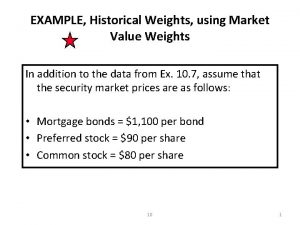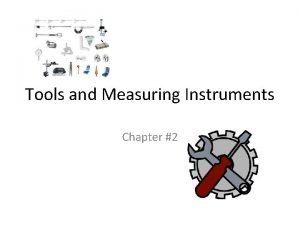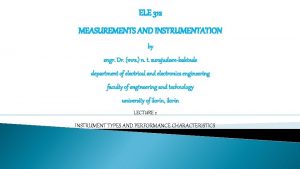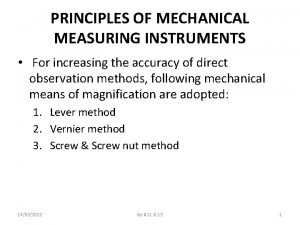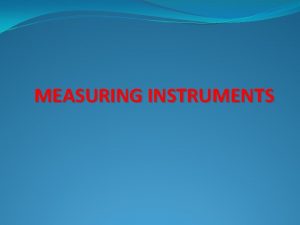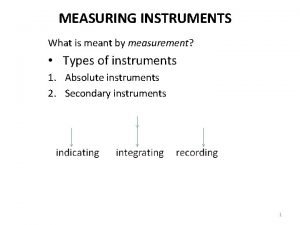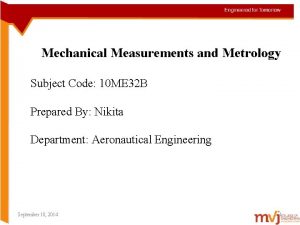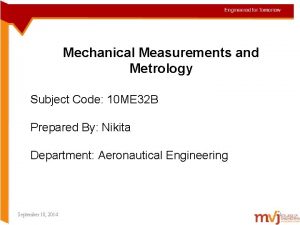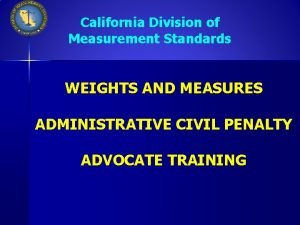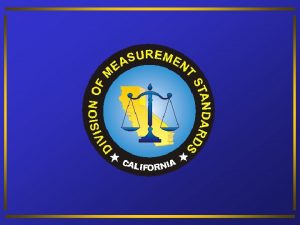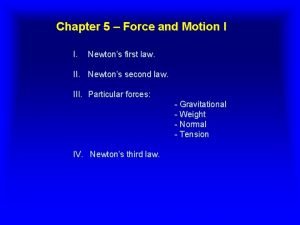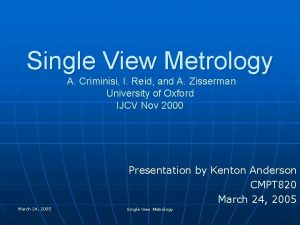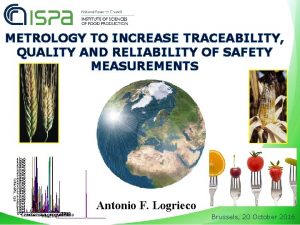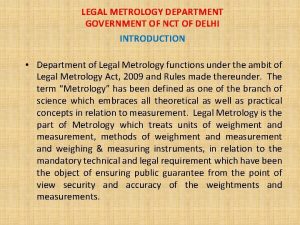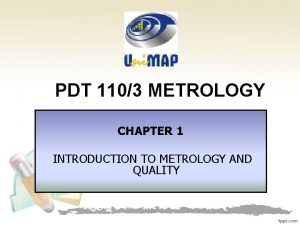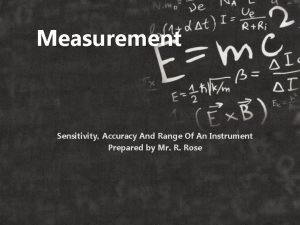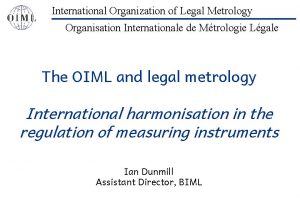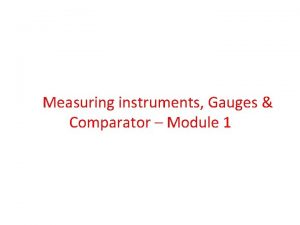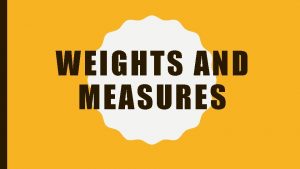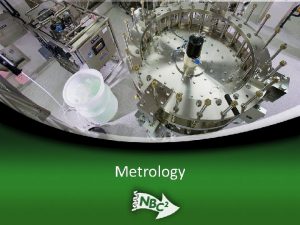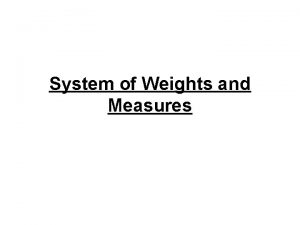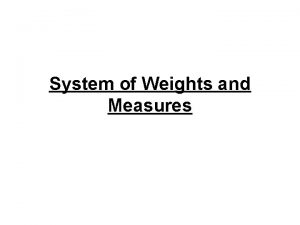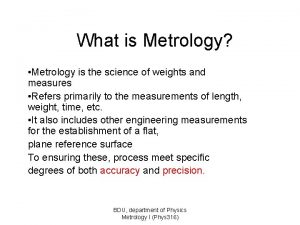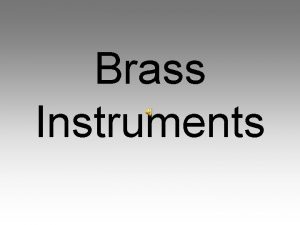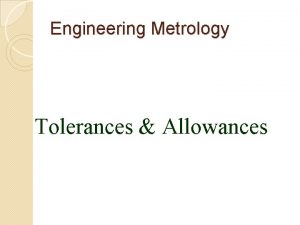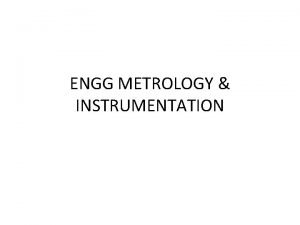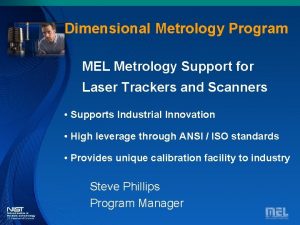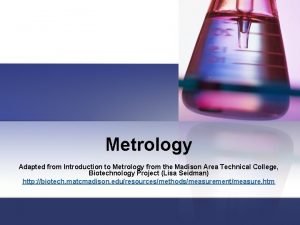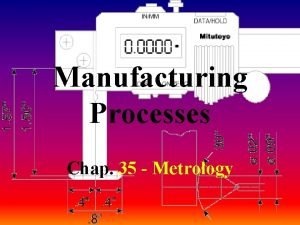Measuring Instruments Metrology n science of weights and








































- Slides: 40

Measuring Instruments

Metrology n science of weights and measures

Discrimination n degree to which a measuring instrument divides a basic unit of length

10 to one rule for discrimination a measuring instrument should discriminate 10 times finer than the smallest unit that it will be used to measure n instrument lands between two lines do not use to measure n

Parallax error n the apparent shift of an object when viewed from different angles

Calibration n Process by which a measuring instrument is compared to a known standard n The international prototype kilogram is a platinum iridium alloy, created in 1879, that is the standard by which all the world’s weight measurements are calibrated. It is lock in a Paris vault and is only brought out on very rare occasions n The length of a meter is defined by the distance light travels in a vacuum in 1/299, 792, 458 seconds


Handle precision measuring instruments with care

Use of precision measuring instruments keep calibrated n when possible, take readings while the instrument is in contact with the work piece n on cylindrical work pieces, check twice - 90 degrees apart n best temperature is 68 degrees F. n

Direct reading instruments

1. Steel Rules

2. Calipers (Can be Vernier, Dial, or Digital Reading) Outside n Inside n Depth n

3. Micrometers (Can be Vernier, Dial, or Digital Reading) n Outside u frame, Inside n Depth n anvil, spindle, sleeve, thimble

Comparison measuring instruments comparing to a known standard n represents a known distance n used in conjunction with an instrument that has the capability of showing measurement n sometimes referred to as transfer measurement n direct reading instruments should be used whenever possible n

Common types 1. spring calipers n 2. telescoping gages n 3. small hole gages n 4. adjustable parallels n 5. radius gages n 6. thickness gages n 7. planer gages (similar to adjustable parallels) n

8. Squares n a. machinists combination square set u protractor u centering head b. solid beam square n c. cylindrical square n

9. Indicators balanced vs. continuous readings n mounting must be rigid n u magnetic bases u flexible link holding arms u height gage applications (test)

2 types of indicators n a. dial u some can be used to make linear measurement u discriminations range from. 00005 to. 001” u ranges are from. 003 to 2. 0” n b. test u used for comparisons only (no direct measurements) u discrimination approx. 0005” u range of about. 030”

Angle Terminology acute angles = < 90 degrees n right angles = 90 degrees n obtuse angles = > degrees n full circle = 360 degrees n 1 degree = 60 minutes of an arc n 1 minute = 60 seconds of an arc n radian = metric unit of angular measurement n

Angle measuring instruments (not for measuring angularity)

1. Plate protractor n discrimination of 1 degree

2. Bevel protractor n part of the machinists combination set - discrimination of 1 degree

3. Universal bevel protractor includes a vernier scale n measure to accurately to within 5 minutes of a degree (remember there are 60 minutes in one degree n

4. Sine bar n 5” and 10” center spacing of cylinders

To find angles with the sine bar: elevate the sine bar with adjustable parallels until the indicator reads zero at each end of the workpiece n parallel is removed and measured with a micrometer n transpose the sine bar elevation formula and solve for the angle n sin of the angle = elevation / sin bar length (5 or 10”) n

Gage blocks n permit comparison between working measurement and instruments of mfg.

Uses: calibration of measuring instruments n establishment of precise angles (with sine bars) n positioning of machine tools and cutting tools n used to set snap gages n

Common set has 81 to 88 blocks

Range in thickness from. 050 to 4. 0”

3 Grades grade 1 = lab n grade 2 = inspection n grade 3 = shop n

Grade on tolerance = +/. 000002”

Tolerance on a stack of 30 gage blocks assembled to represent 20”?

Use as few combinations as possible when stacking

Care avoid unnecessary contact with hands n clean with proper solvents n handle and lay on lint free cloth n don’t leave blocks rung for extended periods of time n spray with a preservative n

Wringing gage blocks

Main cause of gage block wear is wringing poorly cleaned blocks

Checking with optical flats

Wear blocks used in applications where direct contact is made n usually. 050” or. 100” n

Accessories scribes n bases n screw sets n

Other machines Optical comparator n Coordinate measuring machine (CMM) n
 Market value weights
Market value weights Chapter 2 tools and measuring instruments
Chapter 2 tools and measuring instruments Indirect reading instruments
Indirect reading instruments Non-precision instruments are
Non-precision instruments are What is passive instrument
What is passive instrument Indicating instruments and instruments with a signal output
Indicating instruments and instruments with a signal output Mechanical measuring devices
Mechanical measuring devices Define damping torque
Define damping torque Measuring instrument
Measuring instrument Diehl aquarius
Diehl aquarius How many c are in a pt
How many c are in a pt My favourite science
My favourite science Saudi standards, metrology and quality organization
Saudi standards, metrology and quality organization What is software measurement
What is software measurement Diamtral
Diamtral Metrology and measurements subject code
Metrology and measurements subject code Emirates authority for standardization and metrology
Emirates authority for standardization and metrology Weights and measures training
Weights and measures training Construction material weights
Construction material weights Department of measurement standards
Department of measurement standards Mohenjo daro weights and scales
Mohenjo daro weights and scales California weights and measures
California weights and measures He invented over 80 machines using pulleys and weights
He invented over 80 machines using pulleys and weights The two blocks a and b have weights
The two blocks a and b have weights Processing skills in science
Processing skills in science Single view metrology
Single view metrology National metrology institute of japan
National metrology institute of japan Reliability in metrology
Reliability in metrology Legal metrology delhi
Legal metrology delhi International metrology organization headquarters
International metrology organization headquarters Metrology
Metrology Introduction to metrology
Introduction to metrology Pakistan meteorological department
Pakistan meteorological department Sensitivity of an instrument
Sensitivity of an instrument International metrology organization headquarters
International metrology organization headquarters Metrology in short
Metrology in short Metrology
Metrology Metrology
Metrology Ebbing metrology
Ebbing metrology Conclusion on meteorological instruments
Conclusion on meteorological instruments Interchangeability in metrology
Interchangeability in metrology
